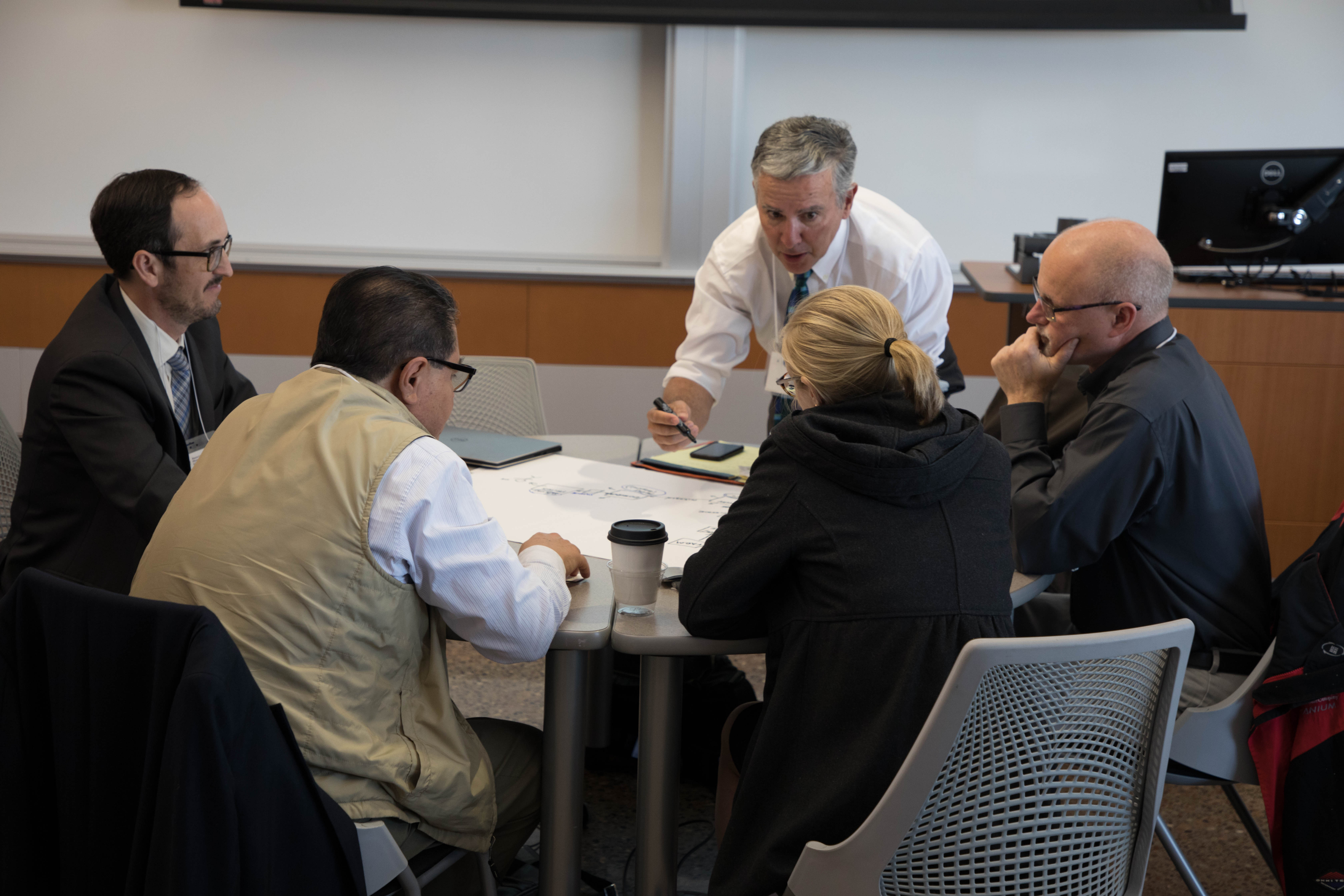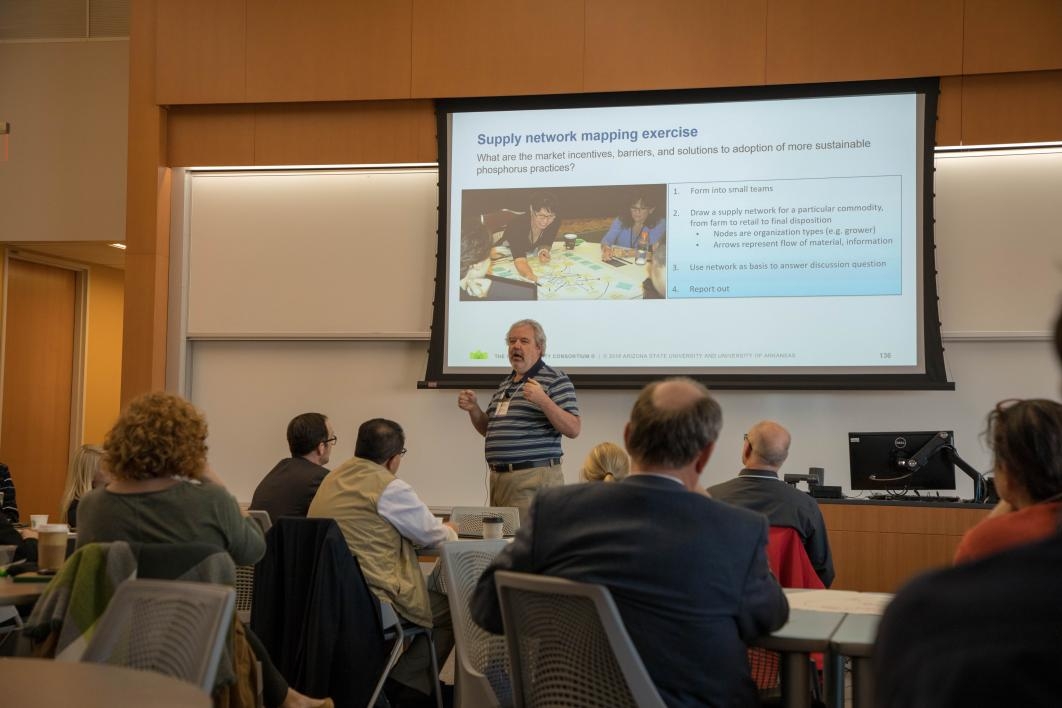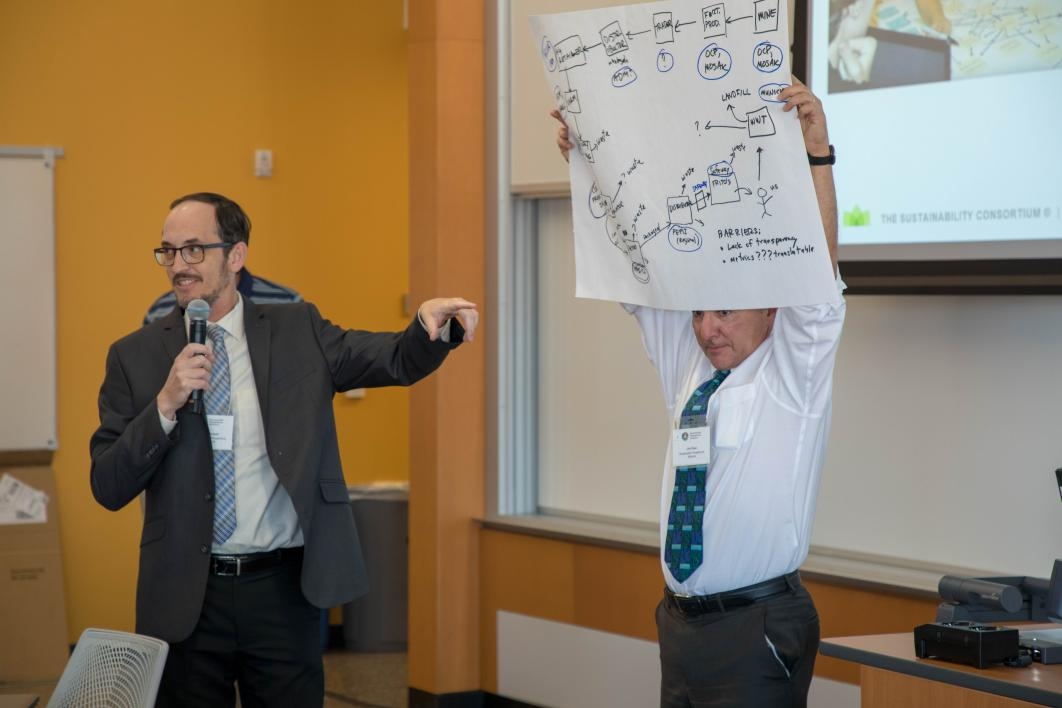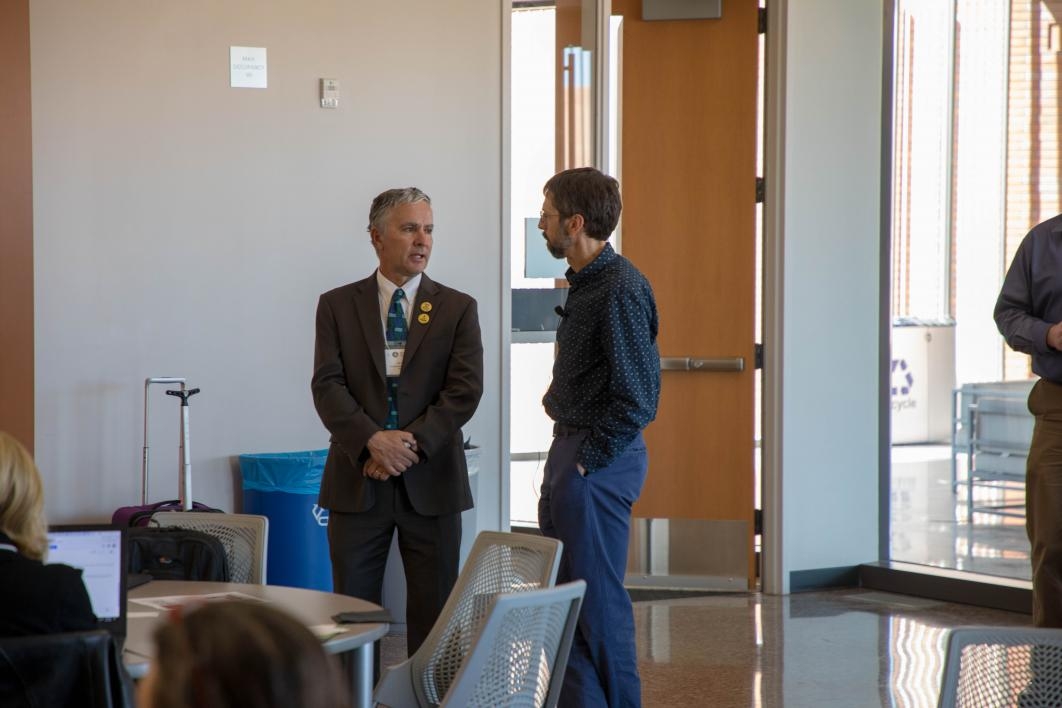Phosphorus for all of us
Sustainable Phosphorus Forum tackles how to feed a future world of 10 billion while protecting water resources

Our relationship with the essential element phosphorus is both personal and global.
“We each carry about three pounds of phosphorus in our bodies and in our bones, and yet, we are fully dependent upon it to feed a future world of 10 billion people by 2050,” said Professor Jim Elser.
Phosphorus is a nutrient crucial to growing crops, but it washes off farmland in the rain and travels to our waterways, where it can cause major pollution issues.
Elser, a long-time Arizona State University professor now at Montana State, initiated the Sustainable Phosphorus Alliance a decade ago. The Sustainable Phosphorus Alliance is a unique partnership made up of academics, industry members and NGOs who are committed to finding a way to have a food system that manages phosphorus while protecting rivers, lakes and oceans. The alliance is located at the Biodesign Institute at ASU in the Biodesign Swette Center for Environmental Biotechnology, with the support of center Director Bruce Rittmann.
Elser, along with organizer and alliance program manager Matt Scholz, served as hosts for the annual forum, held recently at ASU, which centered on themes of sustainable application of phosphorus fertilizers to farms.
Jim Elser (center), along with organizer and alliance program manager Matt Scholz (far left), served as hosts for the annual Phosphorus Forum, held recently at ASU. They tackled the worldwide issue of how to feed a future planet of 10 billion while ensuring adequate clean water for the planet. Photo by Ben Petersen/Biodesign Institute
“The U.S. has made a broad sustainability goal of having zero hunger, and more food to meet expanding markets,” said Elser. “At the same time, we need access to clean water. Making those things happen at the same time is our most critical challenge. How do we get there without going over a cliff?”
More than 50 alliance participants, representing diverse fields in agriculture, supply chain economics, green chemistry, regulatory policy and industry, met at ASU’s McCord Hall to tackle key phosphorus management challenges.
The goals of the forum were to facilitate networking, working groups, and represent the North American sustainability community.
“This is such a vastly complex issue that requires the collaboration of all those who handle nutrients — from the mines and fertilizer companies that produce them to the wastewater treatment plants, compost facilities and manure managers that recycle them,” said Scholz. "These groups don’t usually talk to each other, so our challenge is to create that conversation, build trust and move forward with collaborative solutions.”
Wizards or prophets
Elser framed the forum’s presentations with inspiration from a recent book, “The Wizard and the Prophet: Two Remarkable Scientists and Their Dueling Visions to Shape Tomorrow's World,” by author Charles Mann (“1491” and “1493”).
In an excerpt featured recently in the Atlantic, Mann categorizes two camps of thought to feeding a world of 10 billion. There are the “prophets,” epitomized by William Vogt, who, Mann writes, “argued that affluence is not our greatest achievement but our biggest problem.”
In the other camp are the “wizards” represented by Norman Borlaug. Borlaug, Mann says, “has become the emblem of 'techno-optimism' — the view that science and technology, properly applied, will let us produce a way out of our predicament. He was the best-known figure in the research that in the 1960s created the Green Revolution, the combination of high-yielding crop varieties and agronomic techniques that increased grain harvests around the world, helping to avert tens of millions of deaths from hunger.
Wizards, following Borlaug’s model, “unveil technological fixes; prophets, looking to Vogt, decry the consequences of our heedlessness.”
Their competing mantras could simply be reduced to “Cut back!” vs. “Innovate!” according to Mann.
The problem with P
The same competing mantras exist for the element phosphorus, which is essential for all of life — including humans and the plants we and animals depend upon for the food we eat.
“Humans' closest relationship to the Earth is through agriculture,” said Sally Rockey, executive director of the Foundation for Food and Agricultural Research (FFAR), who gave the keynote address at the forum. “We have to protect our Earth in order to provide for that bounty.”
The world is rapidly using up resources, particularly in high-demand countries such as the U.S. and China. And unless there are improvements and we cut back, their native phosphorus supplies could run out by 2050, according to David Vaccari, professor and director of the Department of Civil, Environmental and Ocean Engineering at the Stevens Institute of Technology.
“China and the U.S. are on the same time scale [just 24-36 years from now] with running out of production,” said Vaccari.
If the estimates are correct, this will make the world more dependent on the greatest source of phosphorus, mines in Morocco. “Globally, we still have hundreds of years,” said Vaccari. But the worry is that there may be more political unrest once countries use up their own supplies.
An important aspect to overcoming these challenges is for the Phosphorus Alliance to adopt the wizard approach of fostering innovation.
And so far, the wizards have kept the phosphorus dilemma at bay. During the past generation, agricultural innovation has pulled off a phosphorus magic trick — increasing crop yield several fold (corn yield has gone up an average of two bushels an acre annually since 1965) while using the same amount of phosphorus for growth, from the work of wizards who have developed new hybrids, expanded irrigation, increased fertilizer rates, and introduced modern transgenic, insect-resistant crops.
Soil health has increasingly become a main factor. President Franklin Roosevelt, when commenting on the dust bowl days and Great Depression, once said, “The nation that destroys its soil destroys itself,” according to Rockey.
That’s why, after a 30-year federal research career leading programs at the USDA and NIH, she now leads the publicly funded nonprofit FFAR, with a $200 million annual budget to foster agricultural innovation. Their group is funding innovation in everything from basic research to improve the efficiency of photosynthesis to overcoming water scarcity to improving urban food systems and sharing these results with the Phosphorus Alliance community.
Perhaps one wizard solution that’s good for the soil and plants could be using an entirely different fertilizer.
The fertilizer we buy at the store contains phosphorus in the form of PO4, or phosphate.
The problem is that scientists estimate that up to 80 percent of the phosphorus may never be taken up by plants, leading to millions of tons of wasted fertilizer.
“The main problem we have in agriculture is that 70 to 80 percent of what we apply to the soil gets fixed into the soil, and the crops only use 20 to 30 percent,” said Luis Herrera, director of the Mexico’s National Laboratory of Genomics for Biodiversity at Cinvestav.
And where do the excess of 35 million tons of fertilizer annually applied to crops go instead? It can lead to runoff and soil erosion and can contaminate our rivers and lakes. Once there, algae can thrive on the overabundance of phosphorus, producing problematic algal blooms and oceanic red tides.
That’s why researchers like Herrera have been trying to come up with a brand-new fertilizer, in the form of phosphite. It has shown early success, using up to 50 percent less fertilizer by using plants genetically changed with an added bacterial component to more readily take up phosphite as their sole phosphorus source. “When you introduce this into an agricultural soil, you should be able to produce the same biomass with using less phosphorus from phosphite rather than phosphate,” Herrera said.
With improvements, he thinks they can reduce the use to only one-third compared with current fertilizers — and with the added benefit of providing weed control — since weeds can’t grow when phosphite is added to the soil.
Increasing sustainable outcomes
Increasingly, phosphorus use is being tied not to crop yields alone, but on having more prophets and sustainable outcomes. Allison Thomson, who works as the science and research director of the independent, 130-member nonprofit Field to Market, benchmarked sustainability performance for leading commodity crops in the U.S, including corn, cotton, potato, rice, soybean and wheat.
Farmers can use their benchmarking tools to help evaluate their farming decisions in sustainable outcomes for biodiversity, energy use, greenhouse gas emissions, irrigated water use, land use, soil carbon, soil conservation and water quality. They compile these against national and state averages, so “the farmer has an immediate sense of how they compare, and how to shrink their footprint.”
ASU supply chain expert Kevin Dooley is chief scientist of the 100-member Sustainability Consortium, which was founded by ASU and the University of Arkansas to look at particular market products’ carbon footprint, particularly for grocers, and was ranked as a Scientific American “Top 10 World Changing Ideas.”
One of the aspects from his survey work is how little connection people have with the food they eat. Not only is it hard for people to figure out where the food on their dinner plate may originally have come from, but even retailers, suppliers and experts can also find it hard to determine.
“How do we create maps that take that field-level data and aggregate it into product-category data?” asked Dooley.
During a forum workshop, he challenged attendees with an exercise, mapping out the market drivers and supply chain for other commodities, from cotton to corn chips to milk.
He asked forum members to focus on “the market incentives, barriers and solutions to adoption of more sustainable phosphorus practices.”
What became apparent is how vast the challenge is in gathering this type of data. There will need to be more transparency and collaboration among growers, buyers and suppliers to manage more sustainable phosphorus outcomes across the supply chain.
Reduce, reuse, recycle, regulate
Among the best ways to prevent excess fertilizer from being lost to runoff into our waterways is to recycle, and the burgeoning Green Economy has seen a number of companies centered on commercializing compost and recycled fertilizer products. These secondary fertilizer-based companies are starting to have a big impact.
For the recycling community, industry leaders Noel Lyons, president of McGill Compost, and Amir Vashovi, president of Green Technologies, showed the value of using reclaimed water and composting.
“We looked at how we utilize renewable biosolids (organic matter recycled from sewage) in an effort to recycle nutrients,” said Vashovi, who won a Small Business of the Year Award for his Florida-based, sewage recycling fertilizer company. His main market targets our home lawns and gardens, a $40 billion market where consumers buy 70 million pounds of fertilizer annually.
“Composting and the use of composting gives a number of very wide benefits,” said Lyons. “Those of us in the composting industry absolutely believe that the future in this area is about soil health.”
Industrial composting takes the idea of backyard composting to new heights. They take food waste, vegetable waste, and wastewater residuals and use industrial-scale processing to make a high-value composting product.
McGill, with operations mostly centered in Ireland and along the East Coast of the U.S., was founded 25 years ago to transform waste by building and operating large-scale composting facilities to market and sell products to rebuild soils for agriculture, landscaping, erosion control or building soccer and football turfs.
“The one thing organic waste has in common is that it all came from the soil,” said Lyons. “Composting is a very good way of fixing that organic waste so that it can go back into the soil.”
This is especially important for reviving depleted soils, to reverse the cycle and restore more arable lands to renew food production.
Finally, another aspect to change societal management of phosphorus is the power of government to regulate that behavior through new legislation.
Ned Beecher, executive director of the Northeast Biosolids and Residuals Association, showed the big picture on biosolid use and federal and state regulations aimed at better managing phosphorus, both for farms, and increasingly in past 10 years, efforts to change homeowners’ behavior with turf and lawn fertilizers.
“Organic wastes are ubiquitous and cause many issues, including filling up landfills and increasing greenhouse gas emissions” said Beecher. “So, there is a drive to get these out of landfills and put them to use because the nutrients available are good for soils and crops.”
These regulations have served to have a positive effect of increasing the use of biosolids on soils to include the reuse of about 60 percent of all wastewater solids annually in the U.S.
MORE: See how your state is doing to correct and improve P imbalance and the biosolids regulations currently in place
Going forward, the alliance will continue to cultivate research and input from its members to maximize the value of phosphorus to feed the planet, while offering best practices to embrace both the mantra of the prophets to cut back and that of the wizards to continuously innovate.
In the end, Elser commented that perhaps it’s time to change the narrative of the tension between the wizard and prophet camps.
“Maybe we ought to be doing something different. Maybe we have the beginning of a new sort of scientist that’s a combination of these things, someone who recognizes the power of scientific innovation, but also has a systems-level view of all the things it takes for human prosperity.”
To learn more about the Sustainable Phosphorus Alliance, and subscribe to new updates, join at phosphorusalliance.org. Follow on Twitter @SustainP or join the LinkedIn group Sustainable Phosphorus Alliance.
Watch the forum presentations
• Vaccari
• Herrera
• Beecher
Top photo: Balancing the needs of feeding a growing population and protecting natural resources in the future is a priority for scientists today. Photo courtesy of pexels.com
More Environment and sustainability
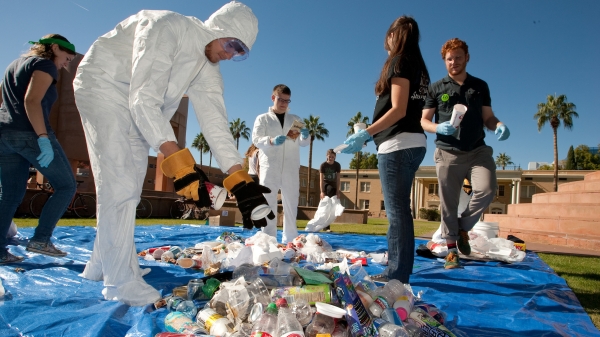
Confusion complicates US recycling efforts
In most major cities and buildings, recycling bins can often be found alongside trash bins in an effort to encourage recycling. But is it working? According to the U.S. Environmental Protection…
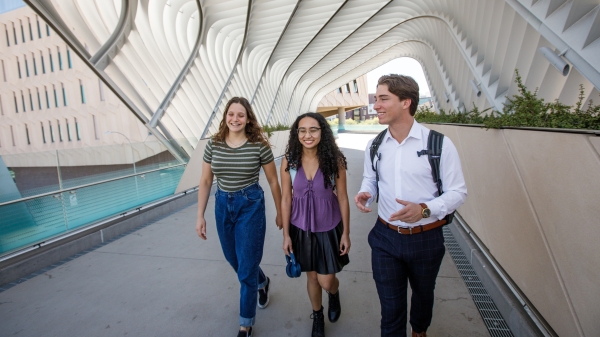
ASU empowers students to build a thriving global future
At Arizona State University, leadership has made tremendous efforts to create programs and initiatives aimed at supporting a healthy planet and thriving future for all life — and now, more than ever…
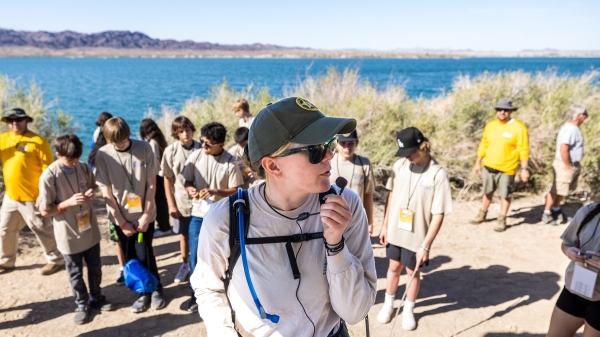
Colorado River becomes an outdoor classroom for these middle school students
Griffin Freburg doesn’t usually look forward to science class. But on a sunny day in March, the eighth grader changed his tune. Concepts that were usually explained in long paragraphs in a textbook…
